Network-Aware Scheduling #
Table of Contents #
- Summary
- Motivation
- Proposal - Design & Implementation details
- Known limitations
- Test plans
- Production Readiness Review Questionnaire
- Graduation criteria
- Implementation history
Summary #
This proposal introduces an end-to-end solution to model/weight a cluster’s network latency and topological information, and leverage that to better schedule latency- and bandwidth-sensitive workloads.
Motivation #
Many applications are latency-sensitive, demanding lower latency between microservices in the application. Scheduling policies that aim to reduce costs or increase resource efficiency are not enough for applications where end-to-end latency becomes a primary objective.
Applications such as the Internet of Things (IoT), multi-tier web services, and video streaming services would benefit the most from network-aware scheduling policies, which consider latency and bandwidth in addition to the default resources (e.g., CPU and memory) used by the scheduler.
Users encounter latency issues frequently when using multi-tier applications. These applications usually include tens to hundreds of microservices with complex interdependencies. Distance from servers is usually the primary culprit. The best strategy is to reduce the latency between chained microservices in the same application, according to the prior work about Service Function Chaining (SFC).
Besides, bandwidth plays an essential role for those applications with high volumes of data transfers among microservices. For example, multiple replicas in a database application may require frequent copies to ensure data consistency. Spark jobs may have frequent data transfers among map and reduce nodes. Insufficient network capacity in nodes would lead to increasing delay or packet drops, which will degrade the Quality of Service (QoS) for applications.
We propose two Network-Aware Scheduling Plugins for Kubernetes that focus on delivering low latency to end-users and ensuring bandwidth reservations in pod scheduling.
This work significantly extends the previous work open-sourced here that implements a latency-aware scheduler extender based on the scheduler extender design.
Goals #
- Define microservice dependencies in an Application via custom resources (AppGroup CRD).
- Describe the network topology for the underlying cluster via weights between regions (
topology.kubernetes.io/region) and zones (topology.kubernetes.io/zone) via custom resources (NetworkTopology CRD). - Make existing scheduler plugins aware of network bandwidth by advertise the nodes' (physical) bandwidth capacity as extended resources.
- Provide a QueueSort plugin TopologicalSort, which orders pods to be scheduled in an AppGroup based on their dependencies.
- Provide network-aware Filter & Score plugins to filter out nodes based on microservice dependencies defined in AppGroup and score nodes with lower network costs (described in NetworkTopology) higher to achieve latency-aware scheduling.
Non-Goals #
- Descheduling due to unexpected outcomes is not addressed in this proposal.
- The conflict between plugins in this proposal and other plugins are not studied in this proposal.
Users are welcome to try plugins in this proposal with other plugins (e.g.,
RequestedToCapacityRatio,BalancedAllocation). However, a higher weight must be given to our plugin ensuring low network costs are preferred.
Use cases / Topologies #
1 - Spark/Database applications running in Data centers or small scale cluster topologies #
Network-aware scheduling examines the infrastructure topology, so network latency and bandwidth between nodes are considered while making scheduling decisions. Data centers with fat-tree topology or cluster topology can benefit from our network-aware framework, as network conditions (i.e., network latency, available bandwidth) between nodes can vary according to their locations in the infrastructure.

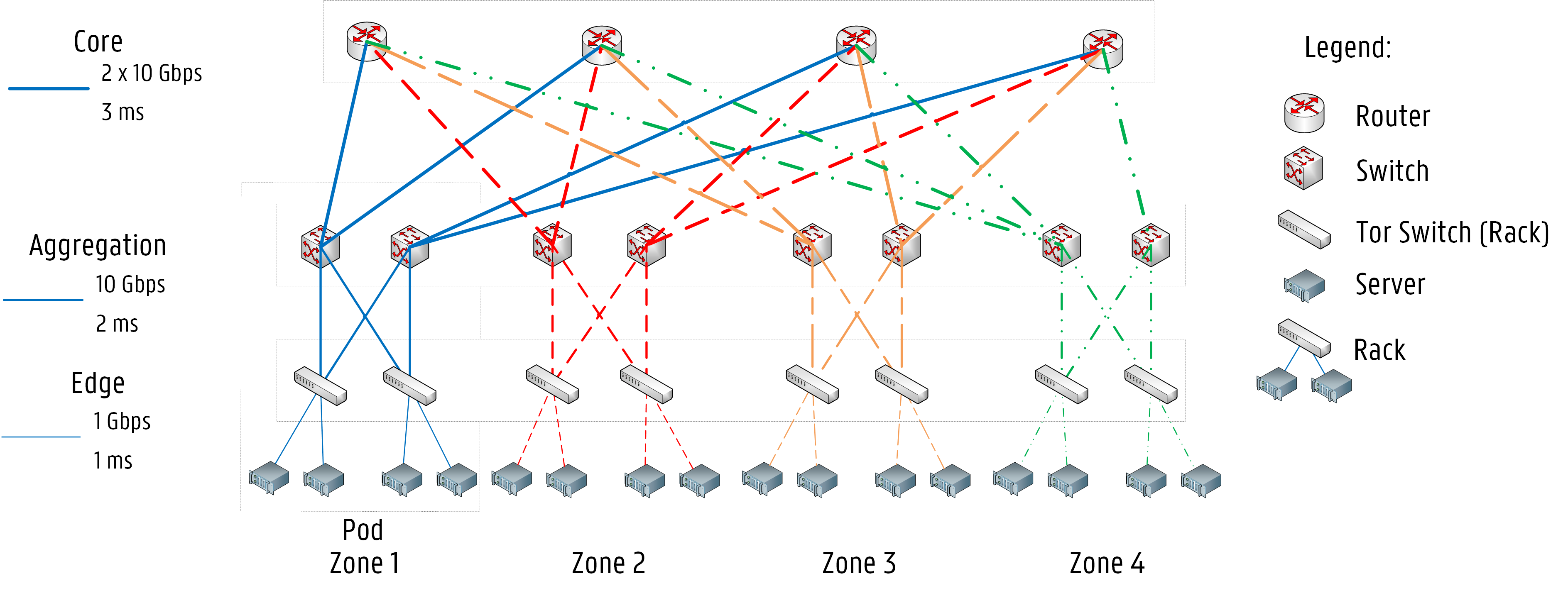
Deploying microservices on different sets of nodes will impact the application’s response time. For specific applications, latency and bandwidth requirements can be critical. For example, in a Redis cluster, master nodes need to synchronize data with slave nodes frequently. Namely, there are dependencies between the masters and the slaves. High latency or low bandwidth between masters and slaves can lead to slow CRUD operations.

2 - Cloud2Edge application running on a multi-region geo-distributed cluster. #
Multi-region Geo-distributed scenarios benefit the most from our framework and network-aware plugins.
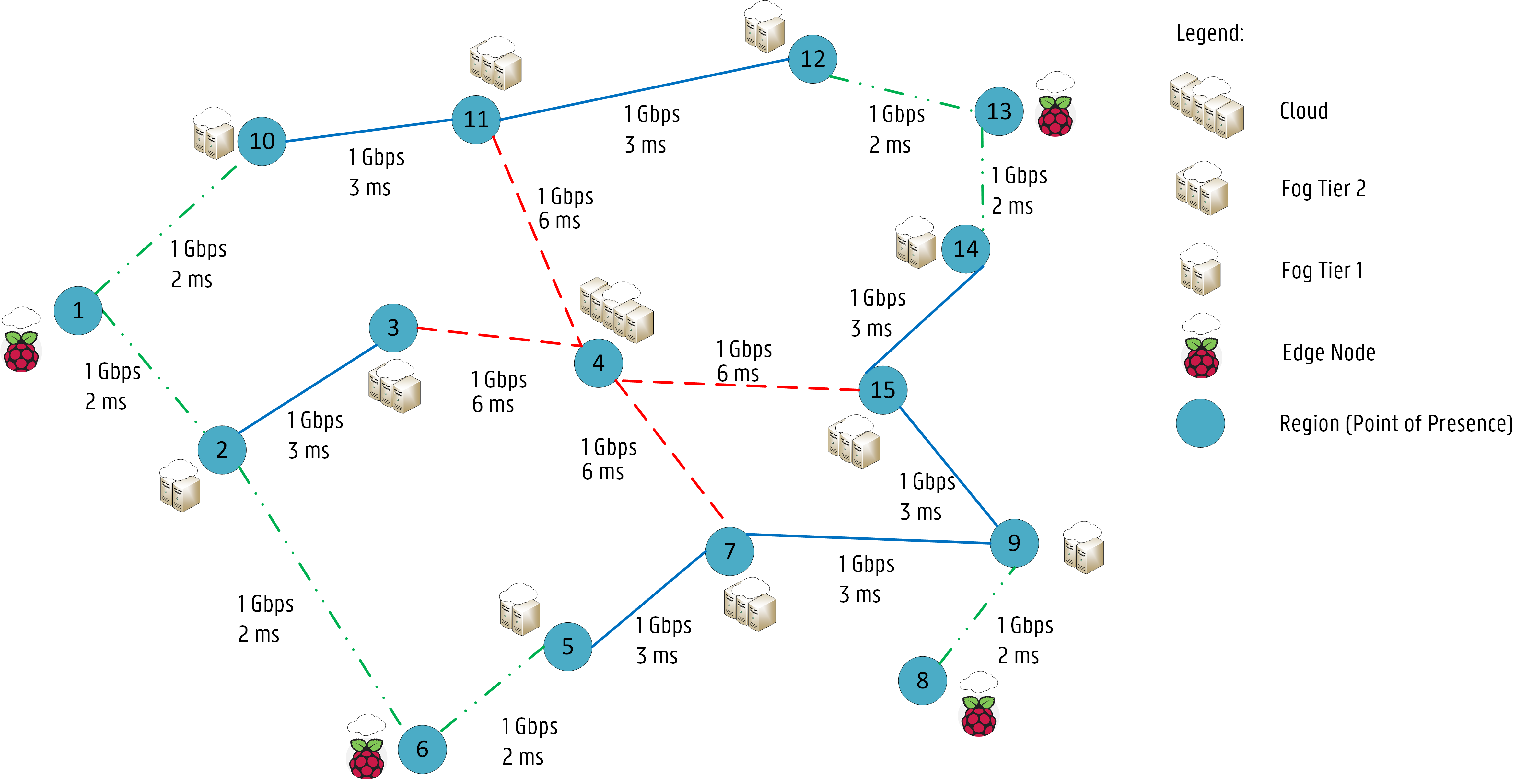
High latency is a big concern in these topologies, especially for IoT applications (e.g., Eclipse Hono, Eclipse Cloud2Edge). For example, in the Cloud2Edge platform, there are several dependencies among the several APIs and MQTT brokers where devices connect to:
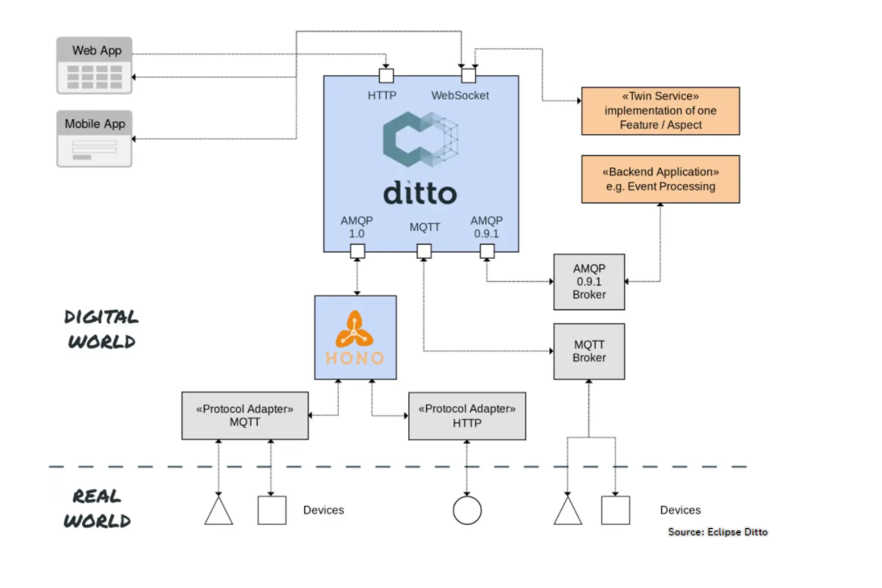
Proposal - Design & Implementation details #
Overview of the System Design #
The proposal introduces two Custom Resources (CRs) defined as Custom Resource Definitions (CRDs):
- AppGroup CRD: abstracts the service topology to maintain application microservice dependencies.
- NetworkTopology CRD: abstracts the network infrastructure to establish network weights between regions and zones in the cluster.
Thus, both application and infrastructure network topology are considered during scheduling.
The proposal also presents a bandwidth resource component (DaemonSet) to advertise bandwidth resources
as extended resources to allow already available filter/scoring plugins (e.g., PodFitsResources,
BalancedAlocation) to consider bandwidth allocation.
As an initial design, we plan to implement two plugins:
-
A QueueSort function named
TopologicalSortsorts pods based on their topology order. Workload dependencies are defined in the AppGroup CRD and then the AppGroup controller via topology sorting algorithms calculates the preferred sequence to schedule these workloads. The plugin favors pods with lower indexes. -
A Filter & Score plugin named
NetworkOverheadwhere nodes are filtered out if they cannot support the network requirements of the Pod’s AppGroup or scored based on network weights ensuring network latency is minimized for pods belonging to the same application.
Further explanations are given below on how the proposed plugins interact with both CRDs.

Application Group CRD #
We designed an AppGroup CRD for service chains leveraging on the Pod Group concept introduced for the Co-scheduling plugin.
The AppGroup associates different workloads (e.g., pods) based on service topology information.
Example #

# Example App Group CRD spec
apiVersion: scheduling.sigs.x-k8s.io/v1alpha1
kind: AppGroup
metadata:
name: a1
spec:
numMembers: 3
topologySortingAlgorithm: KahnSort
workloads:
- workload:
kind: Deployment
apiVersion: apps/v1
namespace: default
name: P1
dependencies:
- workload:
kind: Deployment
apiVersion: apps/v1
namespace: default
name: P2
minBandwidth: "100Mi"
maxNetworkCost: 30
- workload:
kind: Deployment
apiVersion: apps/v1
namespace: default
name: P2
dependencies:
- workload:
kind: Deployment
apiVersion: apps/v1
namespace: default
name: P3
minBandwidth: "250Mi"
maxNetworkCost: 20
- workload:
kind: Deployment
apiVersion: apps/v1
namespace: default
name: P3
An AppGroup controller updates the AppGroup CR regarding the preferred topology order for scheduling workloads.
Currently, six algorithms are supported for topological sorting:
- KahnSort.
- TarjanSort.
- Alternate Kahn.
- Alternate Tarjan.
- Reverse Kahn.
- Reverse Tarjan.
Alternate Kahn modifies the order given by Kahn by selecting the first element of Kahn as its first element, the last of Kahn as its second, the second of Kahn as its third, and so on. AlternateTarjan follows the same pattern of AlternateKahn and modifies the order of Tarjan.
ReverseKahn and ReverseTarjan essentially reverse the order given by Kahn and Tarjan, respectively.
The implementation is based on the work open-sourced here. Each workload has an index based on the sorting algorithm. An index of 1 means the workload should be allocated first in the AppGroup.
// AppGroupController is a controller that process App groups using provided Handler interface
type AppGroupController struct {
eventRecorder record.EventRecorder
agQueue workqueue.RateLimitingInterface
agLister schedlister.AppGroupLister
podLister corelister.PodLister
agListerSynced cache.InformerSynced
podListerSynced cache.InformerSynced
agClient schedclientset.Interface
}
// +genclient
// +k8s:deepcopy-gen:interfaces=k8s.io/apimachinery/pkg/runtime.Object
// AppGroup is a collection of Pods belonging to the same application
type AppGroup struct {
metav1.TypeMeta `json:",inline"`
// Standard object's metadata.
// +optional
metav1.ObjectMeta `json:"metadata,omitempty" protobuf:"bytes,1,opt,name=metadata"`
// AppGroupSpec defines the Min and Max for Quota.
// +optional
Spec AppGroupSpec `json:"spec,omitempty" protobuf:"bytes,2,opt,name=spec"`
// AppGroupStatus defines the observed use.
// +optional
Status AppGroupStatus `json:"status,omitempty" protobuf:"bytes,3,opt,name=status"`
}
// AppGroupSpec represents the template of a app group.
type AppGroupSpec struct {
// NumMembers defines the number of Pods belonging to the App Group
NumMembers int32 `json:"numMembers,omitempty" protobuf:"bytes,1,opt,name=numMembers"`
// The preferred Topology Sorting Algorithm
TopologySortingAlgorithm string `json:"topologySortingAlgorithm,omitempty" protobuf:"bytes,2,opt,name=topologySortingAlgorithm"`
// Workloads defines the workloads belonging to the Appgroup
Workloads AppGroupWorkloadList `json:"workloads,omitempty" protobuf:"bytes,3,opt,name=workloads, casttype=AppGroupWorkloadList"`
}
// AppGroupWorkloadList contains an array of AppGroupWorkload objects.
// +protobuf=true
type AppGroupWorkloadList []AppGroupWorkload
// AppGroupWorkload represents the Workloads belonging to the App Group.
// +protobuf=true
type AppGroupWorkload struct {
// Workload reference Info.
Workload AppGroupWorkloadInfo `json:"workload,omitempty" protobuf:"bytes,1,opt,name=workload, casttype=AppGroupWorkloadInfo"`
// Dependencies of the Workload.
Dependencies DependenciesList `json:"dependencies,omitempty" protobuf:"bytes,2,opt,name=dependencies, casttype=DependenciesList"`
}
// AppGroupWorkloadInfo contains information about one workload.
// +protobuf=true
type AppGroupWorkloadInfo struct {
// Kind of the workload; info: https://git.k8s.io/community/contributors/devel/sig-architecture/api-conventions.md#types-kinds"
Kind string `json:"kind,omitempty" protobuf:"bytes,1,opt,name=kind"`
// Name represents the workload, info: http://kubernetes.io/docs/user-guide/identifiers#names
Name string `json:"name,omitempty" protobuf:"bytes,2,opt,name=name"`
// ApiVersion defines the versioned schema of an object.
//+optional
APIVersion string `json:"apiVersion,omitempty" protobuf:"bytes,3,opt,name=apiVersion"`
// Namespace of the workload
//+optional
Namespace string `json:"namespace,omitempty" protobuf:"bytes,4,opt,name=namespace"`
}
// DependenciesInfo contains information about one dependency.
// +protobuf=true
type DependenciesInfo struct {
// Workload reference Info.
Workload AppGroupWorkloadInfo `json:"workload,omitempty" protobuf:"bytes,1,opt,name=workload, casttype=AppGroupWorkloadInfo"`
// MinBandwidth between workloads
// +optional
MinBandwidth resource.Quantity `json:"minBandwidth,omitempty" protobuf:"bytes,2,opt,name=minBandwidth"`
// Max Network Cost between workloads
// +optional
MaxNetworkCost int64 `json:"maxNetworkCost,omitempty" protobuf:"bytes,3,opt,name=maxNetworkCost"`
}
// DependenciesList contains an array of DependenciesInfo objects.
// +protobuf=true
type DependenciesList []DependenciesInfo
// AppGroupStatus represents the current state of a app group.
type AppGroupStatus struct {
// The number of actively running workloads (e.g., pods).
// +optional
RunningWorkloads int32 `json:"runningWorkloads,omitempty" protobuf:"bytes,1,opt,name=runningWorkloads"`
// ScheduleStartTime of the group
ScheduleStartTime metav1.Time `json:"scheduleStartTime,omitempty" protobuf:"bytes,2,opt,name=scheduleStartTime"`
// TopologyCalculationTime of the group
TopologyCalculationTime metav1.Time `json:"topologyCalculationTime,omitempty" protobuf:"bytes,3,opt,name=topologyCalculationTime"`
// Topology order for TopSort plugin (QueueSort)
TopologyOrder TopologyList `json:"topologyOrder,omitempty" protobuf:"bytes,4,opt,name=topologyOrder,casttype=TopologyList"`
}
// AppGroupTopologyInfo represents the calculated order for a given Workload.
// +protobuf=true
type AppGroupTopologyInfo struct {
// Workload reference Info.
Workload AppGroupWorkloadInfo `json:"workload,omitempty" protobuf:"bytes,1,opt,name=workload, casttype=AppGroupWorkloadInfo"`
// Topology index.
Index int32 `json:"index,omitempty" protobuf:"bytes,2,opt,name=index"`
}
// TopologyList contains an array of TopologyInfo.
// +protobuf=true
type TopologyList []AppGroupTopologyInfo
// +k8s:deepcopy-gen:interfaces=k8s.io/apimachinery/pkg/runtime.Object
// AppGroupList is a collection of app groups.
type AppGroupList struct {
metav1.TypeMeta `json:",inline"`
// Standard list metadata
// +optional
metav1.ListMeta `json:"metadata,omitempty"`
// Items is the list of AppGroup
Items []AppGroup `json:"items"`
}
AppGroup Test based on Online Boutique #
In this test, an AppGroup is created for the Online Boutique application. It consists of 11 workloads each one corresponding to a group of Pods, which we named from P1 - P11.
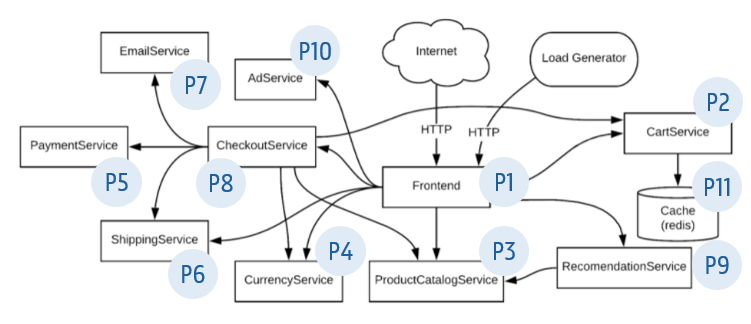
As shown below, the preferred order for the KahnSort algorithm is P1, P10, P9, P8, P7, P6, P5, P4, P3, P2, P11.
We attribute an index to each workload to evaluate their topology preference in the Less function of the TopologicalSort plugin described here. The topology list corresponds to:
topologyList = [(P1 1) (P10 2) (P9 3) (P8 4) (P7 5) (P6 6) (P5 7) (P4 8) (P3 9) (P2 10) (P11 11)]

Significant differences in the ordering of workloads are obtained depending on which topology algorithm is selected, as shown in the next Table:
| Sorting Algorithm | Topological order |
|---|---|
| Kahn | P1, P10, P9, P8, P7, P6, P5, P4, P3, P2, P11. |
| Alternate Kahn | P1, P11, P10, P2, P9, P3, P8, P4, P7, P5, P6. |
| Reverve Kahn | P11, P2, P3, P4, P5, P6, P7, P8, P9, P10, P1. |
| Tarjan | P1, P8, P7, P5, P4, P2, P11, P9, P10, P6, P3. |
| Alternate Tarjan | P1, P3, P8, P6, P7, P10, P5, P9, P4, P11, P2. |
| Reverve Tarjan | P3, P6, P10, P9, P11, P2, P4, P5, P7, P8, P1. |
Network Topology CRD #
We also designed a NetworkTopology CRD leveraging on the current NodeResourceTopology CRD. The goal is to store and update network costs for nodes across regions, zones, or within zones.
As an initial design, network weights can be manually defined in a single NetworkTopology CR where network costs between zones and between regions are specified.
As a separate project, we are providing a networkTopology controller in the future. The controller is designed to react to node additions, updates, or removals, and also update the network weights based on latency measurements.
A netperf component has been developed to execute netperf tests based on the nodes available in the infrastructure. It allows estimating the latency between nodes in the cluster, especially different latency percentiles (i.e., 50th, 90th, and 99th percentile). Latency probing for all pairwise nodes is costly for large-scale clusters. Hence, the initial design assumes that the intra-zone cost between nodes is homogeneous and only the latencies between zones and regions need to be measured.
These measurements are stored and updated in a configmap as key-value pairs with origin and destination as labels. Then, the networkTopology controller accesses the configmap to extract the netperf measurements and calculates accurate network costs across regions and zones in the cluster. The networkTopology controller can then dynamically update the CR accordingly, so scheduling plugins always use the updated network weights instead of the one-time manually configured weights.
The periodical probing of the network latency via the netperf component is only necessary for one pair of nodes between zones/regions. One-time probing between a single pair of nodes is sufficient if nodes within a zone have similar connections. Therefore, the probing is limited, avoiding significant overhead for large-scale clusters.
Furthermore, the networkTopology controller can work with any customized software components that update the configmap. Thus, cloud administrators/developers are free to use different components to obtain network costs according to their own preferences.
Also, the networkTopology controller will maintain the available bandwidth capacity (i.e., bandwidthAllocatable) between regions and zones in the cluster. Pod allocations and corresponding workload dependencies are read from an AppGroup lister, and bandwidth reservations are saved in the networkTopology CR based on pod deployments.
Example #
Let’s consider the following NetworkTopology CRD as an example:
# Example Network CRD
apiVersion: scheduling.sigs.x-k8s.io/v1alpha1
kind: NetworkTopology
metadata:
name: net-topology-test
namespace: default
spec:
configMapName: "netperfMetrics"
weights:
# Region label: "topology.kubernetes.io/region"
# Zone Label: "topology.kubernetes.io/zone"
# 2 Regions: us-west-1
# us-east-1
# 4 Zones: us-west-1: z1, z2
# us-east-1: z3, z4
- name: "UserDefined"
costList: # Define weights between regions or between zones
- topologyKey: "topology.kubernetes.io/region" # region costs
originCosts:
- origin: "us-west-1"
costs:
- destination: "us-east-1"
bandwidthCapacity: "10Gi"
networkCost: 20
- origin: "us-east-1"
costs:
- destination: "us-west-1"
bandwidthCapacity: "10Gi"
networkCost: 20
- topologyKey: "topology.kubernetes.io/zone" # zone costs
originCosts:
- origin: "z1"
costs:
- destination: "z2"
bandwidthCapacity: "1Gi"
networkCost: 5
- origin: "z2"
costs:
- destination: "z1"
bandwidthCapacity: "1Gi"
networkCost: 5
- origin: "z3"
costs:
- destination: "z4"
bandwidthCapacity: "1Gi"
networkCost: 10
- origin: "z4"
costs:
- destination: "z3"
bandwidthCapacity: "1Gi"
networkCost: 10
// +genclient
// +k8s:deepcopy-gen:interfaces=k8s.io/apimachinery/pkg/runtime.Object
// NetworkTopology defines network costs in the cluster between regions and zones
type NetworkTopology struct {
metav1.TypeMeta `json:",inline"`
// Standard object's metadata.
// +optional
metav1.ObjectMeta `json:"metadata,omitempty" protobuf:"bytes,1,opt,name=metadata"`
// NetworkTopologySpec defines the Min and Max for Quota.
// +optional
Spec NetworkTopologySpec `json:"spec,omitempty" protobuf:"bytes,2,opt,name=spec"`
// NetworkTopologyStatus defines the observed use.
// +optional
Status NetworkTopologyStatus `json:"status,omitempty" protobuf:"bytes,3,opt,name=status"`
}
// NetworkTopologySpec represents the template of a NetworkTopology.
type NetworkTopologySpec struct {
// The manual defined weights of the cluster
Weights WeightList `json:"weights,omitempty" protobuf:"bytes,1,rep,name=weights,casttype=WeightList"`
// ConfigmapName to be used for cost calculation (To be used by the Network Topology Controller)
ConfigmapName string `json:"configmapName,omitempty" protobuf:"bytes,2,opt,name=configmapName"`
}
// NetworkTopologyStatus represents the current state of a Network Topology.
type NetworkTopologyStatus struct {
// The total number of nodes in the cluster
NodeCount int64 `json:"nodeCount,omitempty" protobuf:"bytes,1,opt,name=nodeCount"`
// The calculation time for the weights in the network topology CRD
WeightCalculationTime metav1.Time `json:"weightCalculationTime,omitempty" protobuf:"bytes,2,opt,name=weightCalculationTime"`
}
// WeightList contains an array of WeightInfo objects.
// +protobuf=true
type WeightList []WeightInfo
// CostList contains an array of TopologyInfo objects.
// +protobuf=true
type CostList []TopologyInfo
// WeightInfo contains information about all network costs for a given algorithm.
// +protobuf=true
type WeightInfo struct {
// Algorithm Name for network cost calculation (e.g., userDefined)
Name string `json:"name,omitempty" protobuf:"bytes,1,opt,name=name"`
// Costs between regions and zones
CostList CostList `json:"costList,omitempty" protobuf:"bytes,2,rep,name=costList,casttype=CostList"`
}
// TopologyInfo contains information about network costs for a particular Topology Key.
// +protobuf=true
type TopologyInfo struct {
// Topology key (e.g., "topology.kubernetes.io/region", "topology.kubernetes.io/zone").
TopologyKey string `json:"topologyKey,omitempty" protobuf:"bytes,1,opt,name=topologyKey"`
// OriginCosts for a particular origin.
OriginCosts OriginList `json:"originCosts,omitempty" protobuf:"bytes,2,rep,name=originCosts,casttype=OriginList"`
}
// OriginList contains an array of OriginInfo objects.
// +protobuf=true
type OriginList []OriginInfo
// OriginInfo contains information about network costs for a particular Origin.
// +protobuf=true
type OriginInfo struct {
// Name of the origin (e.g., Region Name, Zone Name).
Origin string `json:"origin,omitempty" protobuf:"bytes,1,opt,name=origin"`
// Costs for the particular origin.
Costs []CostInfo `json:"costs,omitempty" protobuf:"bytes,2,rep,name=costs,casttype=CostInfo"`
}
// CostInfo contains information about networkCosts.
// +protobuf=true
type CostInfo struct {
// Name of the destination (e.g., Region Name, Zone Name).
Destination string `json:"destination,omitempty" protobuf:"bytes,1,opt,name=destination"`
// Bandwidth capacity between origin and destination.
// +optional
BandwidthCapacity resource.Quantity `json:"bandwidthCapacity,omitempty" protobuf:"bytes,2,opt,name=bandwidthCapacity"`
// Bandwidth allocatable between origin and destination.
// +optional
BandwidthAllocatable resource.Quantity `json:"bandwidthAllocatable,omitempty" protobuf:"bytes,3,opt,name=bandwidthAllocatable"`
// Network Cost between origin and destination (e.g., Dijkstra shortest path, etc)
NetworkCost int64 `json:"networkCost,omitempty" protobuf:"bytes,4,opt,name=networkCost"`
}
// +k8s:deepcopy-gen:interfaces=k8s.io/apimachinery/pkg/runtime.Object
// NetworkTopologyList is a collection of netTopologies.
type NetworkTopologyList struct {
metav1.TypeMeta `json:",inline"`
// Standard list metadata
// +optional
metav1.ListMeta `json:"metadata,omitempty"`
// Items is the list of NetworkTopology
Items []NetworkTopology `json:"items"`
}
The inclusion of bandwidth in the scheduling process #
Bandwidth Requests via extended resources #
We plan to advertise the node’s (physical) bandwidth capacity of the cluster via extended resources. Bandwidth resources will be advertised as extended resources based on a bandwidth resource component open-sourced here. These component will send HTTP requests to the Kubernetes API server regarding the node’s bandwidth capacity. Also, a PATCH request can be sent manually as the following example:
PATCH /api/v1/nodes/<your-node-name>/status HTTP/1.1
Accept: application/json
Content-Type: application/json-patch+json
Host: k8s-master:8080
[
{
"op": "add",
"path": "/status/capacity/network.aware.com~1bandwidth",
"value": "10000000000"
}
]
Here, the bandwidth capacity of the node is equal to 10 Gbps. We prefer to specify bandwidth in sizes of 1 bps (bits per second):
- 1 Mbit/s = 1000000
- 1 Gbit/s = 1000000000
- 10 Gbit/s = 10000000000
The output will show that the Node has a capacity of 10 Gbps:
"capacity": {
"cpu": "2",
"memory": "2049008iK",
"network.aware.com/bandwidth": "10000000000",
Bandwidth Limitations via the Bandwidth CNI plugin #
Bandwidth limitations will be enforced through the bandwidth CNI plugin. This CNI plugin supports pod ingress and egress traffic shaping to limit container bandwidth. Containers share the host network bandwidth when deployed on the same node. Limiting container bandwidth can prevent mutual interference and improve network stability.
The addition of kubernetes.io/ingress-bandwidth and kubernetes.io/egress-bandwidth annotations
to the pod configuration file ensures bandwidth limitations are respected:
# Example Pod deployment with bandwidth limitations
apiVersion: v1
kind: Pod
metadata:
annotations:
kubernetes.io/ingress-bandwidth: 1M
kubernetes.io/egress-bandwidth: 1M
By installing Calico as the networking plugin, the bandwidth CNI plugin is already installed as default.
Example #
This example shows how extended resources can be combined with bandwidth limitations in the pod configuration file:
# Example Pod deployment:
# bandwidth requests (Extended Resources)
# bandwidth limitations (bandwidth CNI plugin)
apiVersion: v1
kind: Pod
metadata:
name: network-aware-bandwidth-example
annotations:
kubernetes.io/ingress-bandwidth: 10M
kubernetes.io/egress-bandwidth: 10M
spec:
containers:
- name: network-aware-bandwidth-example
image: example
resources:
requests:
network.aware.com/bandwidth: 10000000 # 10M
limits:
network.aware.com/bandwidth: 10000000 # 10M
This allows to perform filter / score algorithms based on bandwidth resources (e.g., PodFitsHostResources, MostRequested, BalancedAllocation).
The Network-aware scheduling Plugins #
Description of the TopologicalSort plugin
#
Extension point: QueueSort
Pods belonging to an AppGroup should be sorted based on their topology information.
The TopologicalSort plugin compares the pods' index available in the AppGroup CRD for the preferred sorting algorithm.
If pods do not belong to an AppGroup or belong to different AppGroups, we follow the strategy of the less function provided by the QoS plugin.
// Less is the function used by the activeQ heap algorithm to sort pods.
// Sort Pods based on their App Group and corresponding service topology.
// Otherwise, follow the strategy of the QueueSort Plugin
func (ts *TopologicalSort) Less(pInfo1, pInfo2 *framework.QueuedPodInfo) bool {
// 1) Check if both pods belong to an AppGroup
(...)
// 2) If one of them does not belong -> Return: Follow the Less function of the QoS Sort plugin.
(...)
// 3) Check if both pods belong to the same AppGroup
(...)
// 4) If Pods belong to the same App Group -> Get AppGroup from AppGroup lister
(...)
// 4.1) Binary search to find both order indexes since topology list is ordered by Workload Name
(...)
// 4.2) Return: a lower index is better, thus invert result!
return !(order(pInfo1) > order(pInfo2))
// 5) Pods do not belong to the same App Group: return and follow the strategy from the QoS plugin
(...)
}
TopologicalSort Example
#
Let’s consider the Online Boutique application shown previously. The AppGroup consists of 11 workloads (11 groups of pods) and the topology order based on the KahnSort algorithm is P1, P10, P9, P8, P7, P6, P5, P4, P3, P2, P11.
The plugin favors low indexes. Thus, depending on the two pods evaluated in the Less function, the result (bool) is the following:
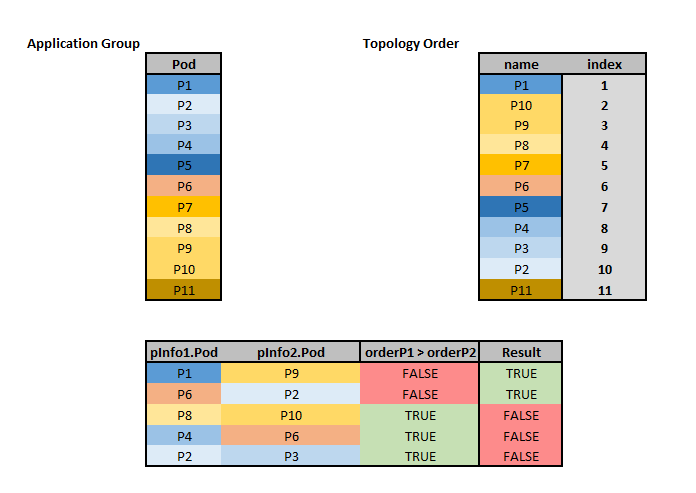
Description of the NetworkOverhead plugin
#
Extension point: Filter #
Workload dependencies established in the AppGroup CR must be respected.
This plugin focuses on maxNetworkCost requirements.
Nodes providing higher network costs than the maxNetworkCost requirement must be filtered out.
Several dependencies may exist since multiple pods can be already deployed on the network.
As an initial design, we plan to filter out nodes that unmet a higher number of dependencies to reduce the number of nodes being scored.
Also, minBandwidth requirements will be considered at a later stage.
based on the bandwidth capacity / allocatable available in each region / zone.
The bandwidth allocatable in each region or zone will be handled by the Network Topology controller previously mentioned.
// Filter : evaluate if node can respect maxNetworkCost requirements
func (pl *NetworkOverhead) Filter(ctx context.Context, cycleState *framework.CycleState, pod *v1.Pod, nodeInfo *framework.NodeInfo) *framework.Status {
// 1) Check if Pod belongs to an AppGroup
(...)
// 2) Check if pods already available (AppGroup lister), otherwise return
(...)
// 3) Check Dependencies of the given pod
(...)
// 4) Retrieve network costs from the NetworkTopology CRD based on the region and zone of the node being filtered
(...)
// 5) Save them in a map to search for costs faster
(...)
// 6) Main Procedure: check if the node is able to meet maxNetworkCost requirements
// For Loop: check all workloads allocated in the cluster and see if dependencies are met if pod is allocated on the node
(...) // If the node being filtered and the pod's hostname is the same node -> numOK = numOK + 1 (dependency respected)
(...) // If Nodes belong to the same zone -> numOK = numOK + 1 (dependency respected)
(...) // Otherwise, retrieve the cost from the map:
(...) // If the cost (retrieved from map) <= dependency MaxNetworkCost -> numOK = numOK + 1 (dependency respected)
(...) // Otherwise: (cost > dependency MaxNetworkCost) -> numNotOK = numNotOK + 1 (dependency not respected)
// 7) If the number of unmet dependencies is higher than the number of respected dependencies: return framework.Unschedulable
if numNotOK > numOK{
return framework.NewStatus(framework.Unschedulable, fmt.Sprintf("Node %v does not meet several
network requirements from Pod dependencies: OK: %v NotOK: %v", nodeInfo.Node().Name, numOK, numNotOK))
// 8) Otherwise, node can schedule the pod: return nil
return nil
}
NetworkOverhead Filter Example
#
Let’s consider the following AppGroup CRD for the appGroup A1 containing three workloads representing pods P1 - P3:
# Example App Group CRD spec
apiVersion: scheduling.sigs.x-k8s.io/v1alpha1
kind: AppGroup
metadata:
name: a1
spec:
numMembers: 3
topologySortingAlgorithm: KahnSort
workloads:
- workload:
kind: Deployment
apiVersion: apps/v1
namespace: default
name: P1
dependencies:
- workload:
kind: Deployment
apiVersion: apps/v1
namespace: default
name: P2
minBandwidth: "100Mi"
maxNetworkCost: 30
- workload:
kind: Deployment
apiVersion: apps/v1
namespace: default
name: P2
dependencies:
- workload:
kind: Deployment
apiVersion: apps/v1
namespace: default
name: P3
minBandwidth: "250Mi"
maxNetworkCost: 20
- workload:
kind: Deployment
apiVersion: apps/v1
namespace: default
name: P3
Then, workloads already allocated in the cluster are retrieved via an AppGroup lister. Two pods have already been allocated: one instance of P2 in node N1 and one instance of P3 in node N4.
Also, the kubernetes cluster has two regions us-west-1 and us-east-1, four zones Z1 - Z4 and eight nodes N1 - N8.
The NetworkTopology CRD is the following:
# Example Network CRD
apiVersion: scheduling.sigs.x-k8s.io/v1alpha1
kind: NetworkTopology
metadata:
name: net-topology-test
namespace: default
spec:
configMapName: "netperfMetrics"
weights:
# Region label: "topology.kubernetes.io/region"
# Zone Label: "topology.kubernetes.io/zone"
# 2 Regions: us-west-1
# us-east-1
# 4 Zones: us-west-1: z1, z2
# us-east-1: z3, z4
- name: "UserDefined"
costList: # Define weights between regions or between zones
- topologyKey: "topology.kubernetes.io/region" # region costs
originCosts:
- origin: "us-west-1"
costs:
- destination: "us-east-1"
bandwidthCapacity: "10Gi"
networkCost: 20
- origin: "us-east-1"
costs:
- destination: "us-west-1"
bandwidthCapacity: "10Gi"
networkCost: 20
- topologyKey: "topology.kubernetes.io/zone" # zone costs
originCosts:
- origin: "z1"
costs:
- destination: "z2"
bandwidthCapacity: "1Gi"
networkCost: 5
- origin: "z2"
costs:
- destination: "z1"
bandwidthCapacity: "1Gi"
networkCost: 5
- origin: "z3"
costs:
- destination: "z4"
bandwidthCapacity: "1Gi"
networkCost: 10
- origin: "z4"
costs:
- destination: "z3"
bandwidthCapacity: "1Gi"
networkCost: 10
Thus, the cluster topology corresponds to the following network graph:

Now, let’s consider that we need to schedule one pod corresponding to the workload P1.
P2 is an established dependency of P1.
So, nodes that do not respect its network cost requirement (i.e., maxNetworkCost: 15) will be filtered out:
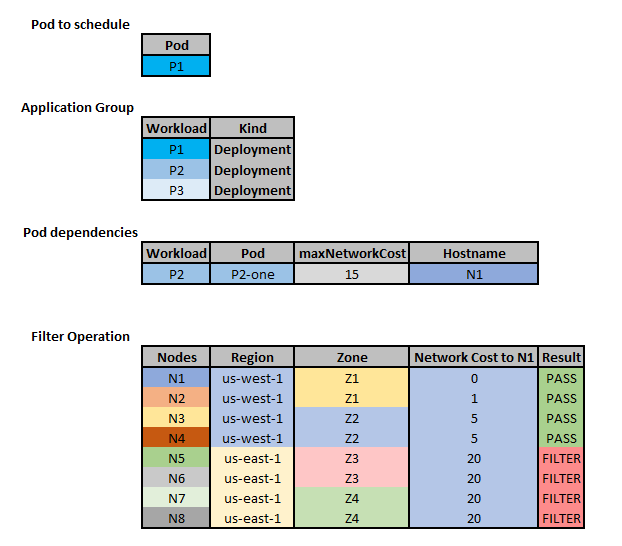
Extension point: Score #
We propose a scoring function to favor nodes with the lowest combined network cost based on the pod’s AppGroup.
Workload allocations are retrieved via an AppGroup lister.
Network weights among regions and zones in the cluster are available in the NetworkTopology CR.
First, we check if pods are already running for the Pod’s AppGroup. Otherwise, we score all candidate nodes equally.
Second, we retrieve network costs related to the node being scored.
Finally, we score the node based on the accumulated network cost related to the workload’s dependencies defined in the AppGroup CR. The accumulated cost is returned as the score:
// Score : evaluate score for a node
func (pl *NetworkOverhead) Score(ctx context.Context, cycleState *framework.CycleState, pod *v1.Pod, nodeName string) (int64, *framework.Status)
// 1) Check if pod belongs to an AppGroup -> return: score all nodes equally
(...)
// 2) Check if workloads are already allocated (Appgroup lister), otherwise score all nodes equally
(...)
// 3) Check Dependencies of the given pod
(...)
// 4) Retrieve network costs from the NetworkTopology CR based on the region and zone of the node being scored
(...)
// 5) Save them in a map to search for costs faster
(...)
// 6) Main Procedure: score the node based on workload allocations and network costs among regions and zones (accumulated cost path)
// For Loop: check all workloads allocated in the cluster and score nodes based on the pod's dependencies already allocated
(...) // If the node being scored and the pod's hostname is the same node -> sum = sum + 0
(...) // If Nodes belong to the same zone -> sum = sum + 1
(...) // Otherwise, retrieve the cost from the map and add to sum -> sum = sum + cost
// 7) Return: Accumulated cost as score
score = sum
return score, framework.NewStatus(framework.Success, "Accumulated cost added as score, normalization ensures lower costs are favored")
}
Then, we get the maximum and minimum costs for all candidate nodes to normalize the values between 0 and 100. After normalization, nodes with lower costs are favored since it also corresponds to lower latency:
// NormalizeScore : normalize scores
func (pl *NetworkOverhead) NormalizeScore(ctx context.Context, state *framework.CycleState, pod *v1.Pod, scores framework.NodeScoreList) *framework.Status {
// Lower scores correspond to lower latency
// 1) Get Min and Max Scores to normalize between framework.MaxNodeScore and framework.MinNodeScore
(...)
// 2) If all nodes were given the minimum score, return
(...)
// 3) Loop: for all scores
(...) // If max != min
(...) // node_normalized_cost = MAX_SCORE * ( ( nodeScore - minCost) / (maxCost - minCost)
(...) // nodeScore = MAX_SCORE - node_normalized_cost
(...) // Else: If maxCost = minCost, avoid division by 0
(...) // node_normalized_cost = MAX_SCORE * - minCost
(...) // nodeScore = MAX_SCORE - node_normalized_cost
// 4) Return after the loop finishes
return nil
}
We plan to combine our scoring plugin with other scoring plugins (e.g., BalancedAllocation, LeastRequestedPriority, etc).
We will attribute a higher weight to our plugin to prefer decisions focused on low latency.
For instance, consider the following scheduler config as an example:
apiVersion: kubescheduler.config.k8s.io/v1beta3
kind: KubeSchedulerConfiguration
leaderElection:
leaderElect: false
clientConnection:
kubeconfig: "REPLACE_ME_WITH_KUBE_CONFIG_PATH"
profiles:
- schedulerName: network-aware-scheduler
plugins:
queueSort:
enabled:
- name: TopologicalSort
disabled:
- name: "*"
filter:
enabled:
- name: NetworkOverhead
score:
disabled: # Preferably avoid the combination of NodeResourcesFit with NetworkOverhead
- name: NodeResourcesFit
enabled: # A higher weight is given to NetworkOverhead to favor allocation schemes with lower latency.
- name: NetworkOverhead
weight: 5
- name: BalancedAllocation
weight: 1
pluginConfig:
- name: TopologicalSort
args:
namespaces:
- "default"
- name: NetworkOverhead
args:
namespaces:
- "default"
weightsName: "UserDefined" # weights applied by the plugin
networkTopologyName: "net-topology-test" # networkTopology CR used by the plugin
NetworkOverhead Score Example
#
Let’s consider the AppGroup CR and NetworkTopology CR shown for the Filter example here
After filtering nodes with the NetworkOverhead plugin, four nodes remain as candidate nodes for the pod corresponding to the workload P1.
Nodes with the lowest combined network costs will be scored higher:
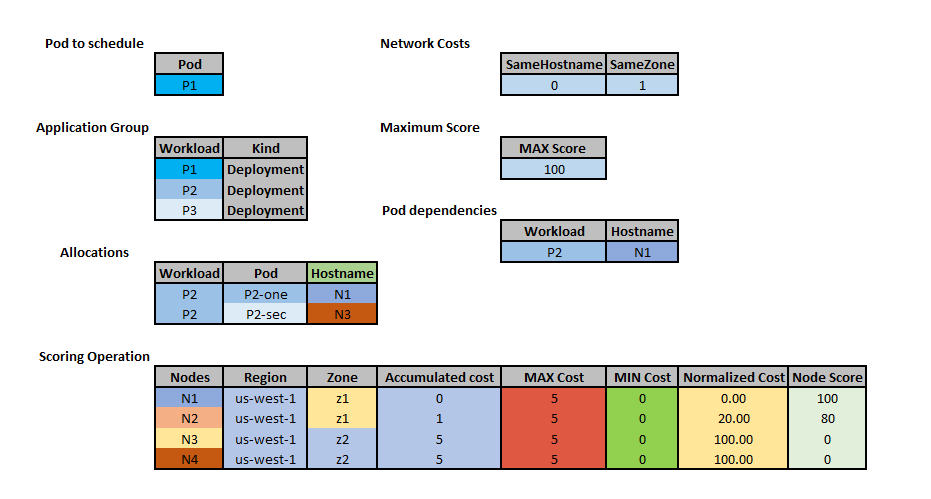
Known limitations #
-
CRDs installation:
The
TopologicalSortplugin depends on the specification of an AppGroup CR.The
NetworkOverheadplugin depends on both CRs (AppGroup and NetworkTopology). Otherwise, it is not able to filter / score nodes.Without both CRDs, the plugins
TopologicalSortandNetworkOverhead(scoring) will follow a default strategy: queue sorting based on the QoS plugin and scoring all nodes equally, respectively. -
QueueSort extension point:
The
TopologicalSortplugin makes use of the QueueSort extension point, so it can’t be combined with other plugins also accessing this extension point. Therefore, when pods do not belong to an AppGroup, we follow the strategy implemented by the QoS sort plugin.
Test plans #
Unit tests and Integration tests will be added:
- Unit Tests
- For both CRs (AppGroup and NetworkTopology) concerning the controllers and respective informers.
- For the two plugins:
TopologicalSortandNetworkOverhead.
- Integration Tests
- Default configurations (plugins enabled / disabled).
- Impact of all plugins in the scheduling flow (performance, resource usage).
- Impact of both CRs (AppGroup and NetworkTopology).
- End-to-end tests
- Comprehensive E2E testing would graduate the framework from Alpha to Beta.
Production Readiness Review Questionnaire #
Scalability #
-
Will enabling / using this feature result in any new API calls?
No.
-
Will enabling / using this feature result in introducing new API types?
No.
-
Will enabling / using this feature result in any new calls to the cloud provider?
No.
-
Will enabling / using this feature result in increasing size or count of the existing API objects?
No.
-
Will enabling / using this feature result in increasing time taken by any operations covered by existing SLIs/SLOs?
Experiments are planned to evaluate the overhead of our design in different topologies.
Nevertheless, it should be a negligible increase concerning execution time since our plugins extract topology information from the NetworkTopology CR and application information from the AppGroup CR.
-
Will enabling / using this feature result in non-negligible increase of resource usage (CPU, RAM, disk, IO, …) in any components?
No - Metrics / Information are available in both CRs and only pulled by our plugins when needed. It should be a negligible increase in terms of resource usage.
Experiments are planned to evaluate the overhead of both CRs and the AppGroup controller.
In addition, the algorithms provided run in linear and logarithmic time for the number of nodes.
Troubleshooting #
-
How does this feature react if the API server and/or etcd is unavailable?
Running pods are not affected. Any new submissions would be rejected by scheduler.
-
What are other known failure modes?
N/A
-
What steps should be taken if SLOs are not being met to determine the problem?
N/A
Graduation criteria #
-
Alpha
- The design and implementation of the AppGroup CRD.
- The design and implementation of the NetworkTopology CRD.
- The implementation of the AppGroup controller (AppGroup CRD).
- The implementation of the NetworkTopology controller (NetworkTopology CRD).
- The development of the bandwidth resource component.
- The implementation of the
TopologicalSortplugin. - The implementation of the
NetworkOverheadplugin. - Unit tests and integration tests from Test plans.
-
Beta
- Add E2E tests.
- Provide beta-level documentation.
Implementation history #
- 2021-9-9: Presentation to the Kubernetes sig-scheduling community. Received feedback and comments on the design and implementation. Recording available here.
- 2021-11-4: Initial KEP sent out for review, including Summary, Motivation, Proposal, Test plans and Graduation criteria.
- 2022-01-11: KEP v0.1 sent out for review after receiving feedback on the initial KEP.
- 2022-01-19: KEP v0.1 revised after feedback. Further details added.
- 2022-02-02: KEP v0.1 updated after revision. Further API modifications.
- 2022-09-06: Creation of the Diktyo-io community for releasing additional network-aware components.
- 2022-12-08: Initial PR merged in sig-scheduling.